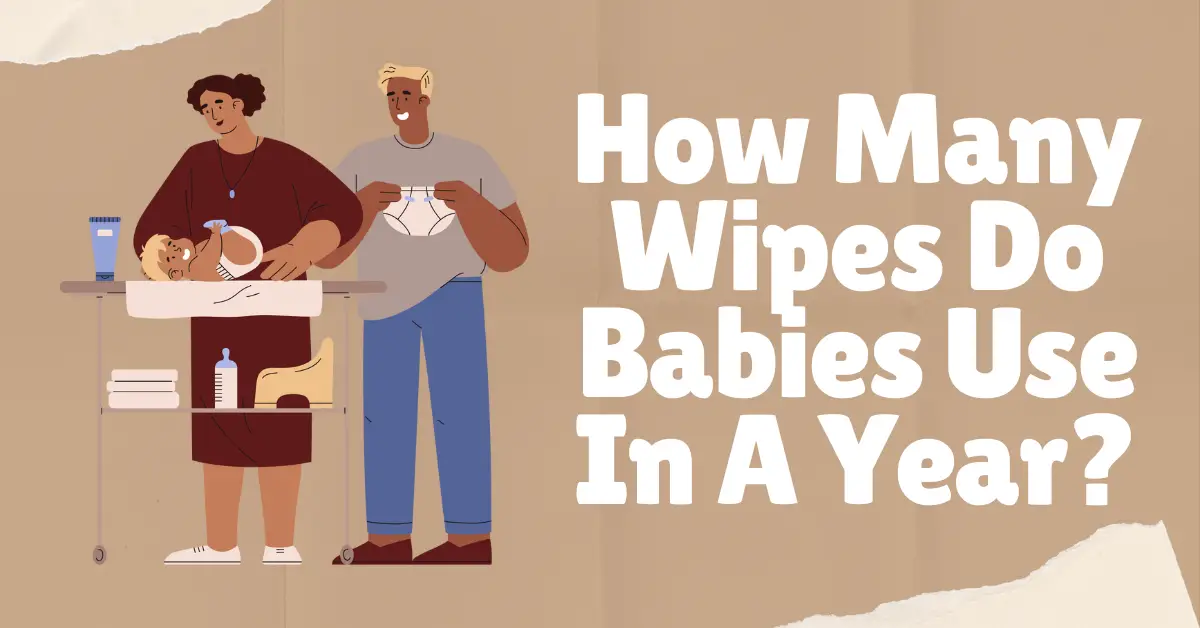One of the most common questions that new parents often ponder is, “How many wipes do babies use in a year?” It’s a valid concern, especially when planning for essential items and budgeting for the baby’s first year. To give a ballpark figure, an average baby can use anywhere between 2,500 to 3,000 wipes per year. This number, however, can vary based on several factors, including the baby’s age, diet, and health.
Understanding the estimated number of wipes can be incredibly beneficial for new parents. Not only does it help in ensuring that you’re always stocked up on this essential item, but it also aids in making informed decisions about which brands to choose, especially if your baby has sensitive skin. As we dive deeper into this article, we’ll discuss the various factors that influence this number and provide insights to help you navigate the world of wet diapers, poopy messes, and the softest wipes for your baby’s delicate skin. Whether you’re setting up your baby registry, planning a baby shower, or just curious about the ins and outs of baby care, this guide is here to assist you.
How Many Wipes Will I Need In The First Year?
From diapers to bottles and, of course, wipes, understanding the numbers can help in planning and budgeting. But when it comes to estimating the number of wipes a baby will use in a year, several factors come into play.
- Daily Diaper Changes: On average, newborns can go through 8-12 diaper changes a day. As they grow, this number gradually decreases. By the time they’re toddlers and showing signs of potty training readiness, the number of diaper changes can be significantly less. Estimating the daily diaper changes and multiplying by the average number of wipes per change can give a rough estimate.
- Nature of Diaper Changes: Not every diaper change is the same. Wet diapers usually require fewer wipes, while a messy poopy diaper can sometimes demand more. Observing patterns and understanding the average number of each type of diaper change can refine the estimate.
- Unexpected Messes: Babies are experts at creating unexpected messes. From food explorations to muddy playtimes, sometimes wipes are used for more than just diaper changes. Factoring in a few extra wipes daily for these unforeseen circumstances can provide a more accurate number.
- Wipe Calculations: 10 diapers per day x 3 wipes per change = 30 wipes per day. 30 wipes per day x 365 days per year = 10,950 wipes per year.
Total Wipes Used In the First Year
Many parents find that the number of wipes needed for the first year hovers around the 10,000 to 11,000 wipes per year mark, though this can vary based on individual circumstances.
Wipes Used Per Day For A Newborn
With an average newborn needing 8-12 diaper changes per day and 3 wipes per change, you’ll use 24 to 36 wipes per day.
Wipes Used Per Month For A Baby
Babies have 8-12 diaper changes per day while using 3 wipes per change. Over a 30-day month that’s 720 – 1,080 wipes used per month.
Real-life Experiences: While calculations and estimates provide a guideline, real life can often be different. Some days might require more wipes, while others less. It’s always a good idea to have a buffer, ensuring you’re never caught off guard. You might also be using your wipes for other things like spills and light cleaning.
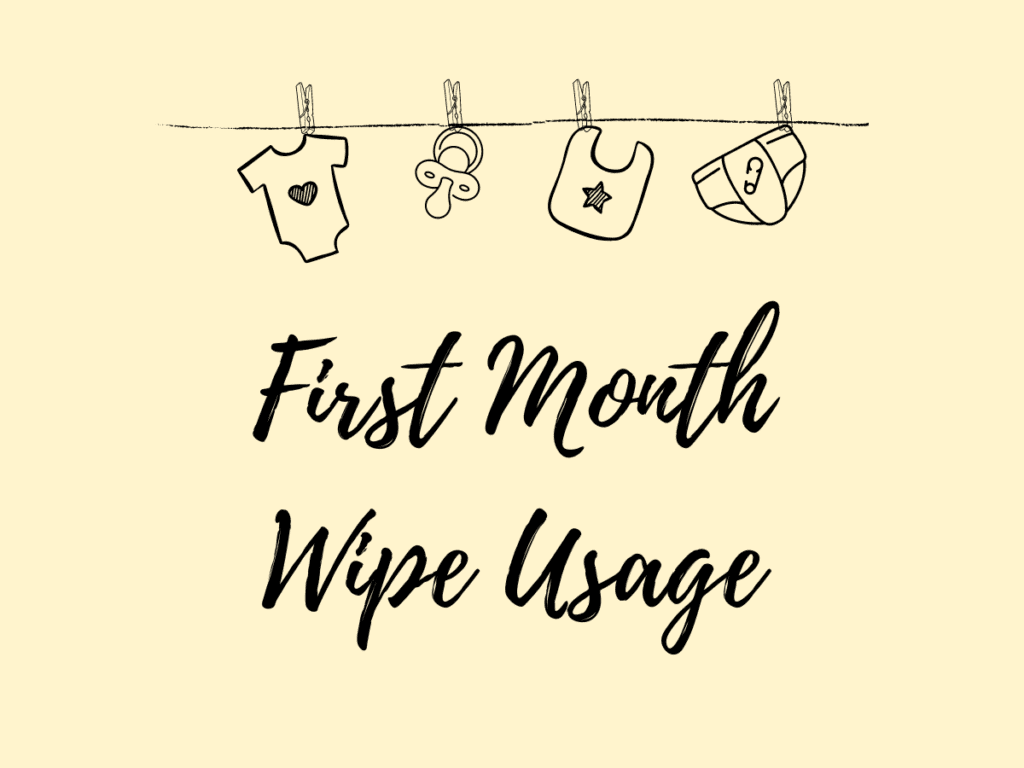
The First Month Wipe Usage
The first month after your baby’s birth is a whirlwind of emotions, adjustments, and, of course, frequent diaper changes. New parents often find themselves in a constant cycle of feeding, burping, and changing diapers. During this initial phase, the number of wipes used can be surprisingly high, especially as parents get the hang of cleaning their newborn baby efficiently.
In the first month, a newborn can have as many as 8-12 diaper changes a day. This is primarily because their diet consists solely of breast milk or formula, leading to more frequent bowel movements. When you factor in both wet diapers and the occasional poopy diaper, the number of wipes used can add up quickly. On average, a wet diaper might require 1-2 wipes, while a more soiled diaper can demand anywhere from 4-6 wipes, depending on the situation.
Another essential aspect to consider during this period is the baby’s sensitive skin. Newborns have incredibly delicate skin, which can be prone to rashes and irritations. As such, it’s crucial to choose wipes that are gentle and free from harsh chemicals. Many new parents opt for brands that specifically cater to newborn babies, ensuring that the wipes are as soft and gentle as possible.
Additionally, the type of diaper used can also influence the number of wipes. Cloth diapers, for instance, might require a few more wipes than disposable diapers, especially if the cloth diaper doesn’t have a liner.
By the end of the first month, as parents become more adept at diaper changes and understand their baby’s patterns better, they might find themselves using fewer wipes per change. However, it’s always a good idea to have extra packs on hand, especially during this initial phase when everything is new and unpredictable.
Diaper Sizes and Their Impact on Wipe Usage
As babies grow, so do their diapers. From the petite newborn size to the larger sizes designed for toddlers, the size of the diaper can have a direct impact on the number of wipes you’ll need for each change. But how exactly does diaper size correlate with wipe usage?
In the early days, newborn diapers are designed to accommodate the frequent and often liquid-like bowel movements of babies. These diapers are smaller and, as a result, can get soiled more quickly. This means that during the initial weeks, you might find yourself reaching for more wipes to ensure your baby’s bottom is thoroughly clean.
However, as babies transition to solid foods and their bowel movements become more solid, the number of wipes required can decrease, even if the diaper size increases. For instance, a poopy diaper for a baby who’s just started on solid foods might require more wipes than a wet diaper for a toddler.
Another factor to consider is the diaper’s absorbency. Newborn diapers are made to be highly absorbent given the frequent changes, but as the diaper size increases, so does its capacity to hold more, which can sometimes mean fewer diaper changes and, by extension, fewer wipes.
It’s also worth noting that as babies grow and become more active, the nature of diaper changes can evolve. Older babies might not stay still during changes, leading to quick, efficient wipes. On the other hand, the introduction of new foods can lead to unexpected messes, requiring a few extra wipes now and then.
Lastly, the choice between cloth diapers and disposable diapers continues to play a role. Cloth diapers, especially those without liners, might require a more thorough cleaning, leading to the use of an extra wipe or two.
In essence, while the size of the diaper does play a role in determining wipe usage, it’s the combination of the baby’s age, diet, and the type of diaper that paints the complete picture.
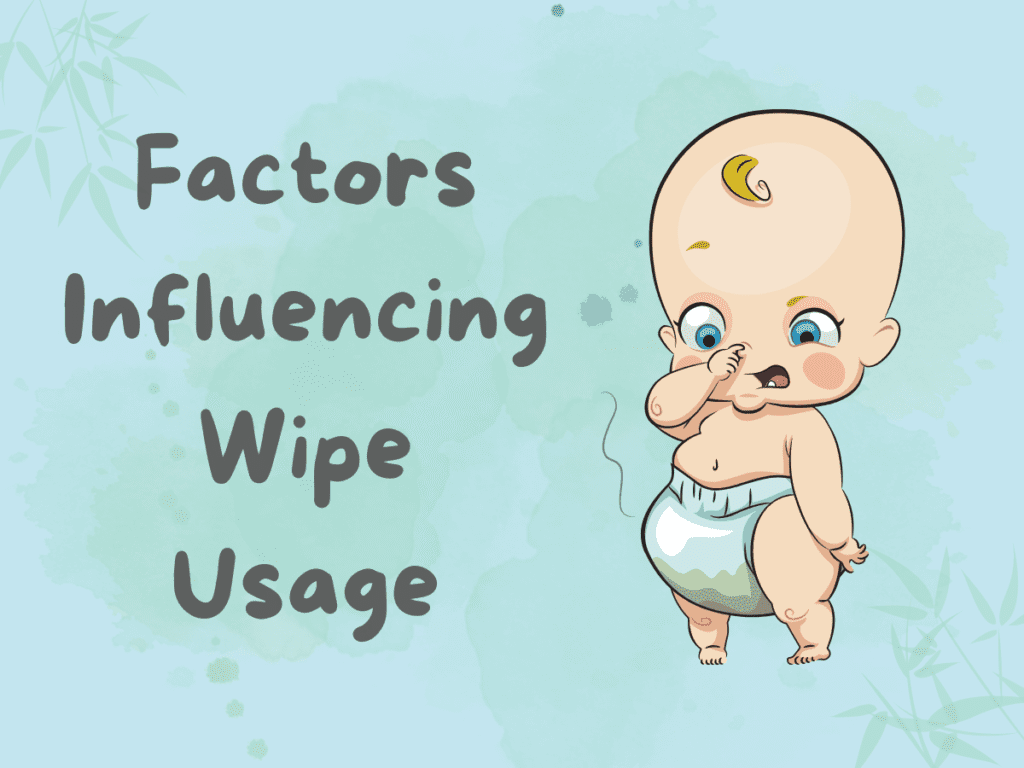
Factors Influencing Wipe Usage
When it comes to the number of wipes a baby uses, several factors come into play. While it’s easy to focus solely on the diaper changes, understanding the broader picture can help new parents make informed decisions and ensure they’re always well-stocked.
- Nature of the Diaper: The difference between a wet diaper and a poopy diaper is significant in terms of wipe usage. Wet diapers typically require fewer wipes, often just one or two, to ensure the baby’s skin is dry. In contrast, a soiled diaper can sometimes demand a more thorough cleaning, especially if the baby has started on solid foods, leading to the use of multiple wipes.
- Baby’s Skin Sensitivity: Babies with sensitive skin might require special attention during diaper changes. Using wipes that are specifically designed for sensitive skin can help prevent rashes and irritations. Sometimes, ensuring the baby’s skin is thoroughly clean and free from any residue might mean using an extra wipe.
- Dietary Changes: The introduction of solid foods is a milestone in a baby’s life and can influence the consistency and frequency of bowel movements. New foods can lead to different textures and, occasionally, more mess, which can impact the number of wipes used.
- Age and Activity Level: Younger babies, especially in their first few months, tend to have more frequent diaper changes. However, as they grow and start moving around, the nature of diaper changes can shift. An active baby might require quick changes, influencing the number of wipes used.
- Type of Wipes: Not all baby wipes are created equal. Some are thicker and more moist, allowing for efficient cleaning with fewer wipes. On the other hand, thinner wipes might require parents to use more to achieve the same level of cleanliness.
- External Factors: Beyond diaper changes, babies are naturally curious and can often find themselves in messy situations. Whether it’s exploring their food with their hands or getting into a bit of mischief, sometimes wipes are needed for more than just diaper changes.
Adaptability is key. While estimates and averages provide a guideline, each baby is unique. Their habits, preferences, and needs can vary, influencing the number of wipes they use. Being observant and understanding these influencing factors can help parents navigate this aspect of baby care with ease and confidence.
Cloth Diapers vs. Disposable Diapers Impact On Wipe Usage
The debate between cloth diapers and disposable diapers is as old as modern parenting itself. Both options come with their own set of advantages and challenges, and the choice often boils down to personal preferences, environmental concerns, and lifestyle. But how do these choices impact the number of wipes you’ll use?
- Environmental Impact: Cloth diapers are often hailed for their reduced environmental impact. They’re reusable, cutting down on landfill waste. However, they require water and energy for washing. On the flip side, disposable diapers contribute significantly to landfills but offer the convenience of single-use. When considering wipes, cloth diapers might lead to using slightly more wipes, especially if they don’t come with a liner, to ensure thorough cleaning.
- Convenience and Efficiency: Disposable diapers are designed for convenience. They’re highly absorbent and often come with features like wetness indicators. This can sometimes mean fewer diaper changes and, consequently, fewer wipes. Cloth diapers, depending on their design and the inserts used, might require more frequent changes, especially if they become soiled.
- Cost Implications: While cloth diapers require an initial investment, they can be cost-effective in the long run, especially if used for more than one child. Disposable diapers, though convenient, come with ongoing costs. When it comes to wipes, parents might find that the savings from using cloth diapers allow them to invest in higher quality or specialized wipes, especially if their baby has sensitive skin.
- Skin Health: Some parents find that cloth diapers, being made of natural fibres, are gentler on a baby’s skin, reducing the risk of diaper rash. This might mean fewer wipes used for cleaning during a rash outbreak. However, disposable diapers are designed to wick away moisture effectively, which can also prevent rashes.
- Lifestyle Considerations: For families always on the go, disposable diapers—and their accompanying wipes—offer ease. They’re easy to pack, use, and discard. Cloth diapers require a bit more planning, especially when travelling, and might lead to carrying extra wipes for thorough cleaning on the go.
The choice between cloth and disposable diapers is deeply personal and can influence wipe usage in various ways. While cloth diapers might lead to using a few more wipes, the overall environmental footprint is smaller. Disposable diapers, with their convenience, might mean fewer wipes per change but come with other considerations. As with many aspects of parenting, it’s about finding the balance that works best for each family’s unique needs.
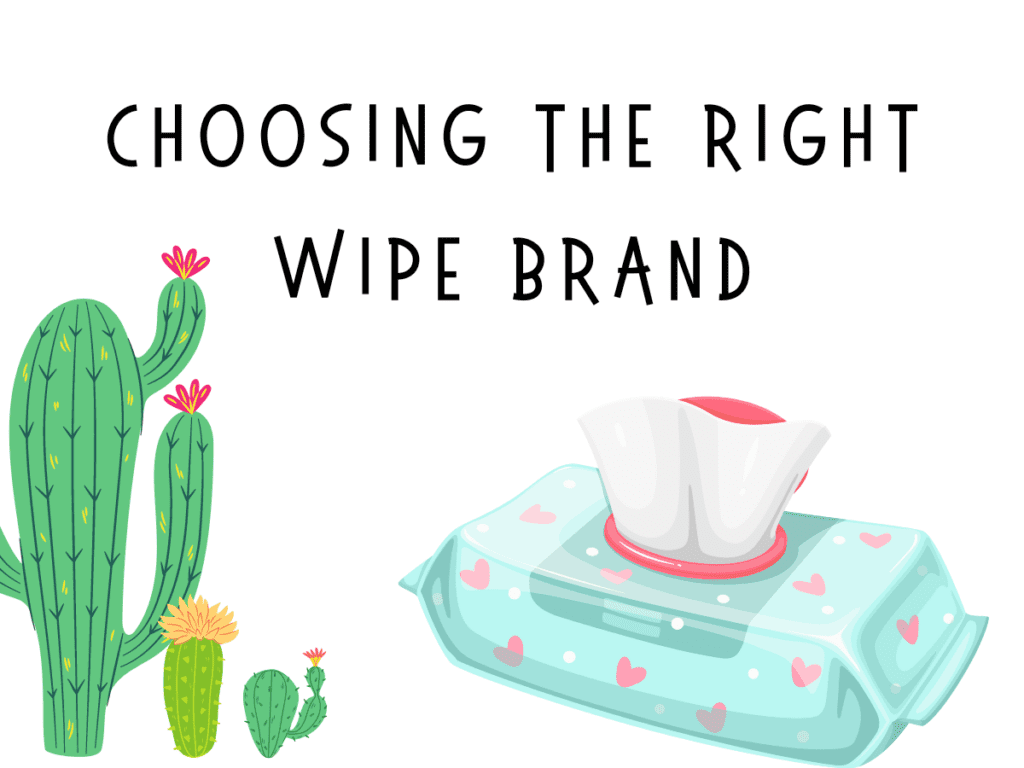
Choosing The Right Wipe Brand
Navigating the baby aisle at any store can be overwhelming for new parents. Shelves lined with different brands, pack sizes, and claims about quality can make the simple task of choosing baby wipes seem daunting. However, understanding the nuances of these choices can make a significant difference in your baby’s comfort and your peace of mind.
- Brands Matter: Not all baby wipes are created equal. Some brands cater specifically to babies with sensitive skin, ensuring their products are free from harsh chemicals, fragrances, and potential irritants. Brands that prioritize natural and organic ingredients might be a good choice for parents concerned about what touches their baby’s skin.
- Thickness and Moisture Content: The thickness of a wipe can influence its cleaning power. Thicker wipes can handle messier situations better, often requiring fewer wipes per change. Similarly, wipes with a higher moisture content can help in cleaning up sticky messes but might not be suitable for babies who are prone to diaper rash.
- Pack Sizes and Shelf Life: Buying in bulk might seem like a cost-effective option, and often it is. However, parents should be aware of the shelf life of baby wipes. Over time, wipes can dry out, especially if not sealed properly. Checking the expiration date and ensuring proper storage can prevent the wastage of dried-out wipes.
- Eco-friendly Options: With growing environmental concerns, many brands now offer biodegradable or compostable wipes. These are especially appealing to parents who are conscious of their environmental footprint. While they might come at a slightly higher price point, the environmental benefits can be worth the investment.
- Special Features: Some wipes come with added features like soothing aloe vera or vitamin E, which can be beneficial for babies with sensitive or irritated skin. Others might have a textured surface for better cleaning. Depending on your baby’s needs, these features can influence the number of wipes used.
- Cost vs. Quality: While it’s tempting to opt for the most economical option, it’s essential to balance cost with quality. Sometimes, investing in higher-quality wipes can mean using fewer of them, leading to long-term savings.
We were always a Huggies wipes family. We found them to be the best balance of toughness and wetness. We found Kirkland to not be moist enough and Pampers were fine but not sold at Costco so we rarely bought them.
Additional Uses of Baby Wipes Beyond Diaper Changes
Baby wipes, while primarily designed for diaper changes, are versatile tools in a parent’s arsenal. Their gentle formulation combined with their convenience makes them invaluable for a range of situations. Here’s a look at some of the myriad ways baby wipes come to the rescue beyond the changing table.
- Mealtime Messes: Babies exploring solid foods can create quite the spectacle. From sticky fingers to smeared faces, baby wipes are perfect for quick clean-ups, ensuring your little one is fresh post their culinary adventures.
- On-the-Go Cleanups: Whether it’s a day at the park or a visit to the grandparents, babies have a knack for finding messes. Wipes can be used to clean hands, faces, and even surfaces, making them a must-have in any diaper bag.
- Artistic Endeavors: As babies grow and start to dabble in art, be it with crayons, paints, or even food, wipes can help in cleaning up these creative messes, ensuring their artistic expressions don’t leave a lasting mark on furniture or walls.
- Potty Training Assistance: When babies transition to potty training, wipes can be a gentler alternative to toilet paper, especially for the initial stages, ensuring the process is comfortable for them.
- Quick Surface Wipes: From high chairs to play tables, baby wipes can be used for a quick wipe-down of surfaces, ensuring they’re clean for your baby’s next adventure.
- Emergency Spill Cleanups: Spilled milk, juice, or water? Baby wipes can come to the rescue, helping clean up minor spills before they become sticky messes.
- Soothing Skin: Some baby wipes, especially those with aloe vera or other soothing ingredients, can be used to refresh and soothe the skin, especially during hot days or after sun exposure.
- Parental Uses: Parents too can benefit from the gentle cleaning power of baby wipes. From removing makeup to freshening up during a busy day, the uses are endless.
In essence, while baby wipes are essential for diaper changes, their utility extends far beyond. Their gentle, effective cleaning combined with their portability makes them a staple in any household with a baby. Over time, many parents find themselves reaching for the pack of baby wipes even as their kids grow, a testament to their versatility and convenience.
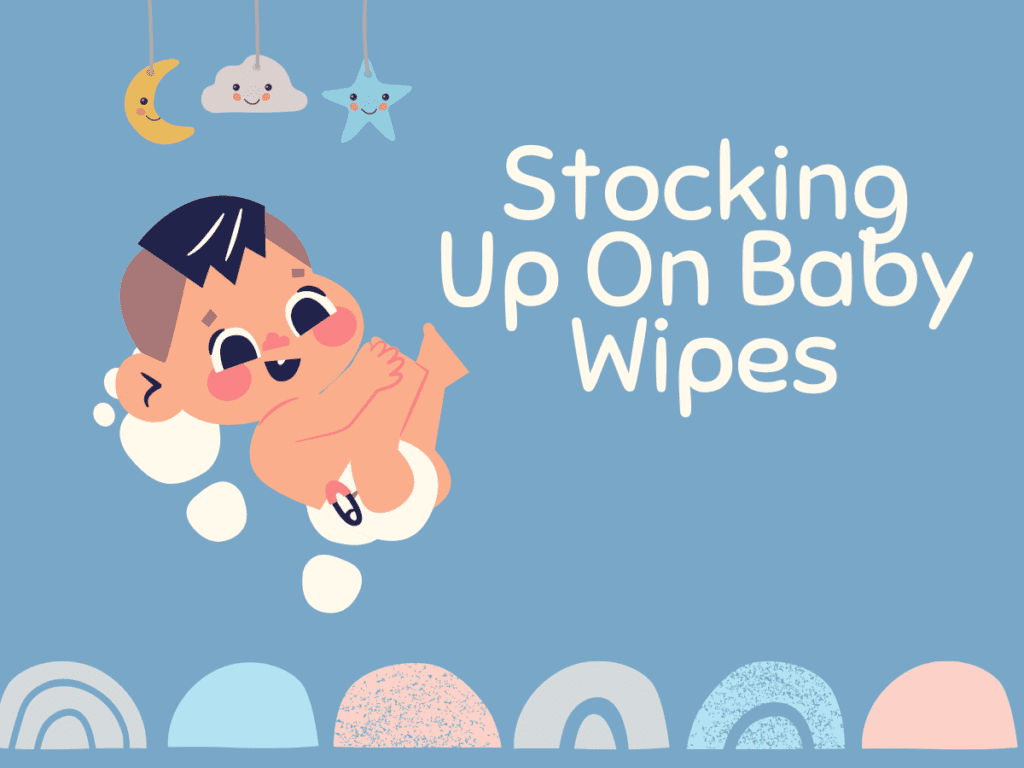
Stocking Up On Baby Wipes
The first year of a baby’s life is filled with growth, milestones, and countless memorable moments. Amidst all the excitement, ensuring you’re well-prepared with essential items like baby wipes can make daily routines smoother. Here’s a guide to stocking up and ensuring you’re always ready for every diaper change and messy situation.
- Bulk Buying: Purchasing baby wipes in bulk can be cost-effective and ensures you have a steady supply. However, it’s essential to check the expiration date and ensure proper storage to maintain the moisture and quality of the wipes.
- Baby Registry and Baby Showers: These events are perfect opportunities to stock up on essential items. Including baby wipes in your baby registry or hinting at them for your baby shower can help you accumulate a good stash before the baby arrives.
- Diversify Brands: While having a preferred brand is common, it’s a good idea to have a few packs from different brands. Babies’ skin can be unpredictable, and what works one month might cause irritation the next. Having a variety ensures you can switch if needed.
- Specialized Wipes: For babies with extra sensitive skin or specific needs, it might be worth investing in specialized wipes, like water wipes or those designed for eczema-prone skin. Having a few packs on hand can be beneficial.
- Storage Solutions: Proper storage can extend the life of your baby wipes. Consider investing in a good-quality storage box or container that seals well. This not only keeps the wipes fresh but also ensures they’re easily accessible.
- Monthly Check: Set a reminder to check your wipe stash monthly. This helps you gauge your usage patterns and ensures you never run out unexpectedly.
- Eco-friendly Choices: If environmental concerns are a priority, consider stocking up on biodegradable or reusable wipes. While they might require a different storage solution, they can significantly reduce waste.
- Emergency Packs: Always have a small pack of baby wipes in your car, purse, or any other place you frequently visit. You never know when they might come in handy, and having an emergency pack can be a lifesaver.
While the exact number of wipes you’ll need in the first year can vary, being prepared and well-stocked ensures you’re ready for every situation. Regular checks, proper storage, and understanding your baby’s unique needs can guide your purchasing decisions, ensuring the baby’s first year is as smooth and joyful as possible.
Wrapping Up How Many Wipes Do Babies Use In A Year
Parenthood is filled with countless joys, challenges, and learning experiences. Among all the questions and concerns that new parents face, understanding the nuances of baby care essentials like wipes is crucial. While it might seem like a minor detail in the grand scheme of things, the right wipes can make a world of difference in ensuring your baby’s comfort and well-being.
From the first month’s frequent diaper changes to the toddler years filled with unexpected messes, the role of baby wipes extends far beyond the changing table. Their versatility, combined with their gentle cleaning power, makes them an indispensable tool in every parent’s toolkit.
As we’ve explored in this guide, several factors influence the number of wipes a baby might use in a year. From dietary changes to the type of diapers used, each baby’s unique needs and habits play a role. While estimates provide a starting point, the real-life experiences of parents often paint a more comprehensive picture.
For new parents embarking on this beautiful journey, the key lies in being prepared while staying adaptable. Understanding your baby’s needs, being aware of the various options available, and making informed choices can ensure that you’re always ready to handle every messy situation with grace.
In the end, while numbers and brands matter, what’s truly essential is the love and care that goes into every diaper change, every cleanup, and every gentle wipe. Here’s to the beautiful journey of parenthood, filled with memories, growth, and countless moments of joy.

